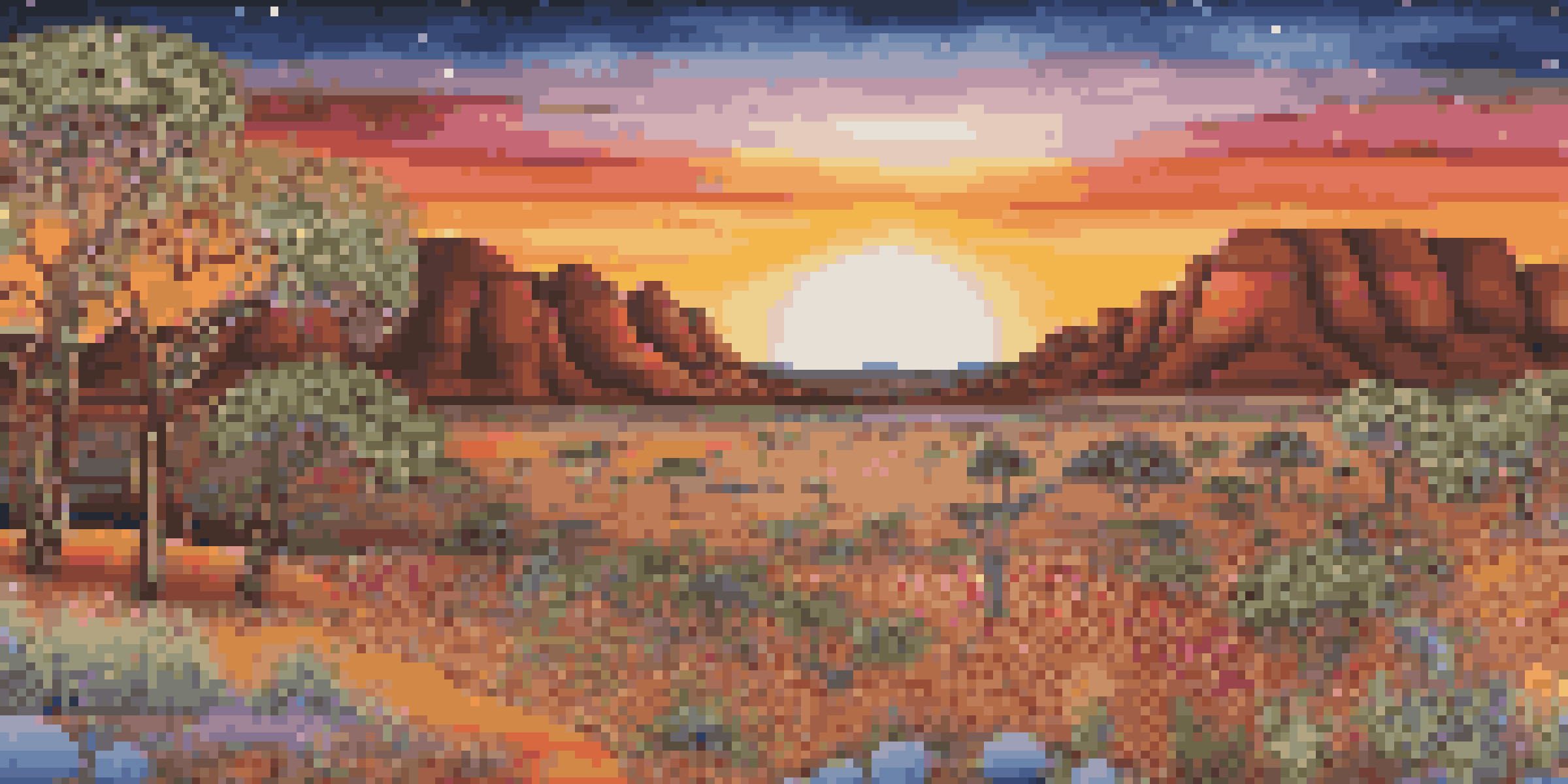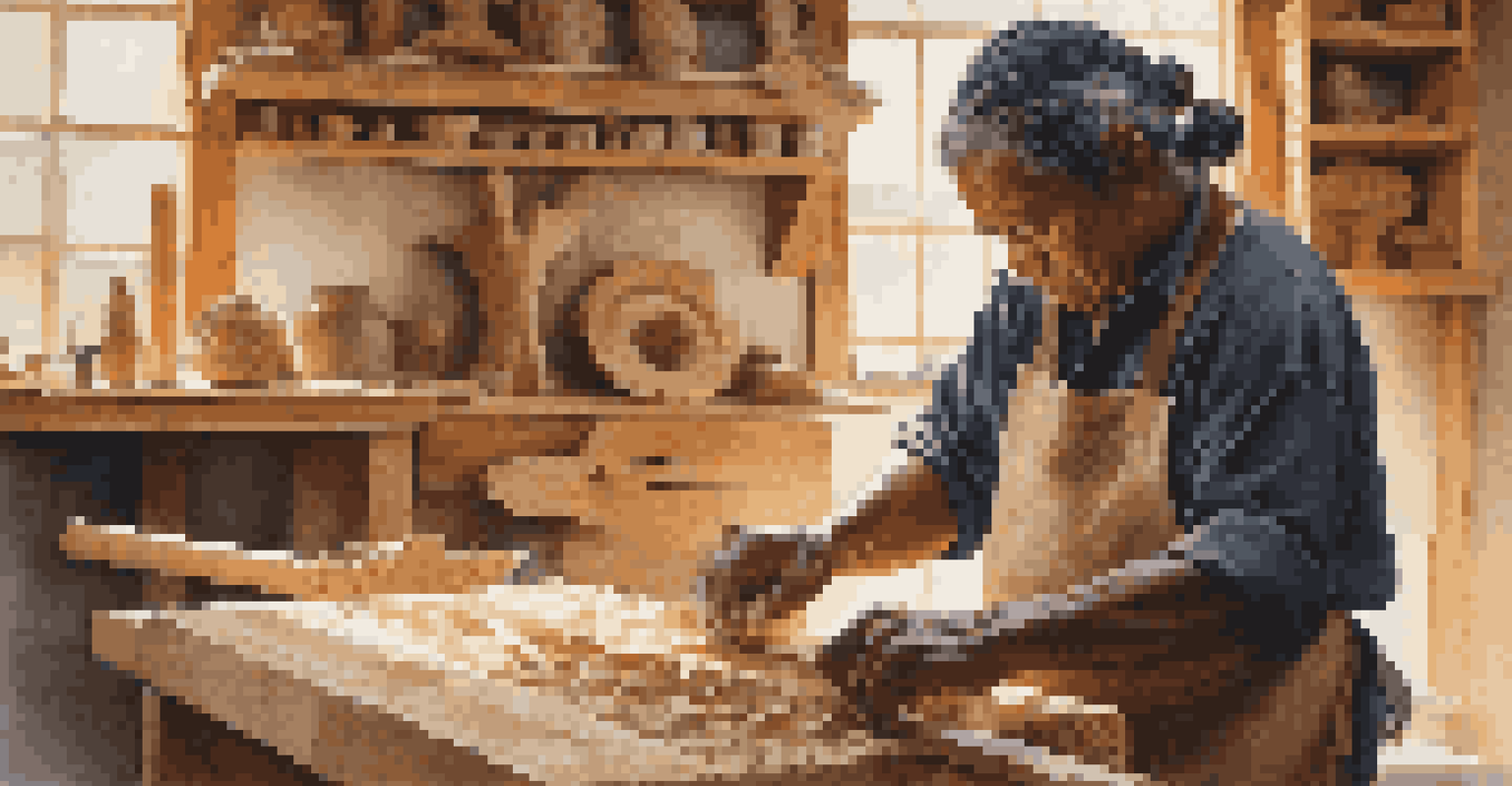Exploring the Global Market for Indigenous Art Forms

Understanding Indigenous Art: A Global Perspective
Indigenous art encompasses a vast array of creative expressions that reflect the traditions, beliefs, and histories of native cultures worldwide. From vibrant paintings to intricate carvings, these art forms often tell stories that have been passed down through generations. Understanding this art requires an appreciation of the cultural context in which it was created, highlighting the unique perspectives of indigenous peoples.
Art is a way of expressing who we are, where we come from, and what we believe in.
Each piece of indigenous art carries a significance that transcends its aesthetic appeal, often serving as a medium for cultural preservation and identity. For example, Aboriginal dot paintings from Australia are not just visually stunning; they encapsulate the deep connection between the land and the artists. This relationship underscores the importance of protecting indigenous art as a vital cultural heritage.
As we explore the global market for indigenous art, it's essential to recognize that these art forms are not merely commodities. They embody the spirit of their creators and often reflect social and political issues faced by indigenous communities today. Thus, understanding indigenous art requires a multifaceted approach that considers both artistic value and cultural significance.
The Economic Impact of Indigenous Art Markets
The market for indigenous art has grown significantly in recent years, contributing to the economic stability of many indigenous communities. Sales from these art forms provide essential income for artists, allowing them to sustain their practices and pass on their culture to future generations. This economic boost not only benefits individual artists but also supports broader community initiatives.

Moreover, as global interest in authentic and culturally rich art increases, indigenous art often fetches high prices in galleries and auctions. This trend highlights the shift in consumer preferences towards unique, handmade items that tell a story. Collectors and art lovers alike are beginning to recognize the value of supporting indigenous artists and their craft.
Indigenous Art as Cultural Heritage
Indigenous art serves as a vital medium for cultural preservation and identity, reflecting the traditions and histories of native cultures worldwide.
However, the commercialization of indigenous art also poses challenges, such as the risk of cultural appropriation and exploitation. It is crucial for buyers and sellers to engage ethically and responsibly with indigenous art, ensuring that artists receive fair compensation for their work. By fostering a respect-driven marketplace, we can create a sustainable environment for indigenous art to thrive.
Cultural Appropriation vs. Appreciation in Art
Cultural appropriation occurs when elements of one culture are adopted by another, often without understanding or respect for their significance. In the realm of indigenous art, this can manifest as non-indigenous artists or businesses profiting from indigenous designs without proper acknowledgment or compensation. This practice can dilute the meaning behind the art and undermine the artists' cultural heritage.
Indigenous art is not just art; it is a narrative of culture, history, and identity.
On the flip side, cultural appreciation involves a genuine respect for and understanding of different cultures. It encourages engagement with indigenous communities, learning from their traditions, and supporting their artists. This approach fosters a more equitable relationship where the true value of indigenous art is recognized and celebrated.
Navigating the line between appropriation and appreciation requires sensitivity and open dialogue. Buyers should seek to educate themselves about the cultural contexts of the art they admire and engage directly with indigenous artists whenever possible. By doing so, we can contribute to a marketplace that honors traditions while promoting fair and respectful exchanges.
Promoting Indigenous Art through Digital Platforms
In today's digital age, online platforms have revolutionized how indigenous art is showcased and sold. Artists can now reach global audiences without the need for intermediaries, providing them with greater control over their work and its representation. This accessibility has opened up new avenues for income and visibility, allowing indigenous voices to be heard more widely.
Social media, in particular, has become a powerful tool for indigenous artists to share their stories and connect with potential buyers. Platforms like Instagram and Etsy enable artists to display their work and build a community around their craft. For instance, a simple post can spark interest in a particular piece, leading to sales that support the artist’s livelihood.
Economic Growth through Art Sales
The growing market for indigenous art provides essential income for artists and supports the economic stability of indigenous communities.
However, while digital platforms offer significant opportunities, they also require artists to navigate the complexities of online marketing. Educating themselves about branding, photography, and social media engagement is essential for success. By embracing these tools, indigenous artists can not only enhance their visibility but also foster a deeper understanding of their culture.
The Role of Art Collectives in Indigenous Communities
Art collectives play a pivotal role in supporting indigenous artists by providing resources, training, and networking opportunities. These collaborative spaces often foster creativity and innovation, allowing artists to share techniques and ideas. Collectives can also help elevate the visibility of their members, leading to more significant exposure and sales.
For example, the Indigenous Fine Arts Market in New Mexico brings together a diverse group of artists to showcase their work to a broader audience. This event not only promotes individual artists but also emphasizes the richness of indigenous culture as a whole. By participating in such initiatives, artists can strengthen their community ties and build a supportive network.
Moreover, art collectives often advocate for the rights of indigenous artists, ensuring they are compensated appropriately for their work. This advocacy is crucial in combating issues like exploitation and cultural appropriation. By standing together, artists can amplify their voices and demand recognition for their contributions to the art world.
Challenges Faced by Indigenous Artists Today
Despite the growing interest in indigenous art, artists still face numerous challenges that can hinder their success. One significant issue is access to resources, such as materials, training, and marketing support. Many artists work in remote areas where these resources are limited, making it difficult for them to develop their skills and reach markets.
Additionally, there is often a lack of representation of indigenous artists in mainstream galleries and exhibitions. This absence can perpetuate stereotypes and misunderstandings about indigenous cultures. By advocating for greater inclusion and visibility, we can help ensure that these artists receive the recognition they deserve.
Navigating Cultural Appropriation
Understanding the distinction between cultural appropriation and appreciation is crucial for fostering respectful relationships with indigenous artists.
Finally, the pressure to conform to certain expectations or styles can be stifling for indigenous artists. They may feel compelled to create work that aligns with market trends rather than expressing their true cultural narratives. Encouraging artists to embrace their unique voices while providing them with a platform to share their stories is vital for the continued growth and evolution of indigenous art.
The Future of Indigenous Art in a Globalized World
As globalization continues to shape the world, the future of indigenous art holds both promise and uncertainty. On one hand, increased connectivity can lead to greater appreciation and demand for indigenous art forms. As more people become aware of the rich histories and cultures behind these works, they may seek to support indigenous artists in meaningful ways.
Conversely, globalization can also pose threats, such as the dilution of cultural identities and the risk of homogenization. It is crucial for indigenous communities to maintain their unique traditions while engaging with broader markets. Striking this balance will be essential for the survival and evolution of indigenous art forms in the years to come.

Ultimately, the future of indigenous art will depend on the collaboration between artists, collectors, and advocates. By fostering respectful relationships and supporting ethical practices, we can help ensure that indigenous art continues to thrive as a vital part of our global cultural landscape.